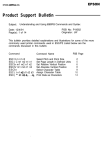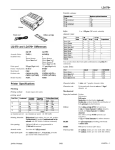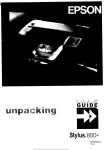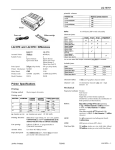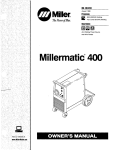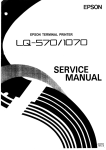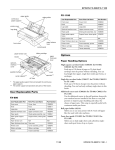Download Epson LQ-1070 Product Information Guide
Transcript
LQ-570/1070 Characterfonts: ! Fort1 I I 1 Epson Drafi Epson Cower Epson Roman 1 Epson San6 Sent Epson Presllge ~Epson Scnpt I Epson Sormt C Epson Orator 1 Epson Orator-S I OCR-B IPoint 10.5 pl i7P’ / 15cpl , 1Ocpl , 12cpl lo 10 !o / Pitch 10 IO 0 i0 IO IO 10 /O I IO I j0 10 IO 0 / Proptilonel j 1 10 IO I 10 You can also select other font/pitch combinations using ESC/P 2 commands. Scalable fonts: Font Ribbon cartridge Power cord Printer Specifications Mgh-speed draft DraR I Letter quality Chemcten per Inch 10 10 / 12 110 ! 12 l/6 inch, l/8 inch, or programmable in 1/36&nch increments Paper feed speed: 77.6 milliseconds per l/&inch line; 2.2 inches per second with continuous feed Friction Push-tractor Pull-tractor Single-bin cut-sheet feeder (optional) Double-bin cut-sheet feeder (by combination of both optional cut-sheet feeders) Black ribbon cartridge #7753 (LQ-570) or #I7754 (LQ-1070): Life expectancy ln LQ, at 48 dots/character: 2 million characters In draft, at 28 dots/character: 3.42 million characters Film ribbon cartridge #7768 (LQ-570) or #7770 (LQ-2070) (optional): Life expectancy In LQ, at 48 dots/character: 0.2 million characters (#7768), 0.3 million characters (#7770) MCBF: For all components (excluding print head): 3 million lines M7BF: LQ-570: 4OCO power-on hours (25% duty) LQ-1070: 6000 power-on hours (25% duty) Print head life: 2OOmillionstrokesperwire(withfabricribbon) 100 million strokes per wire (with film ribbon) Printable columns: Buffer: 24-Pin Printers ~2 Pt 14 international character se6 and 1 legal character set Cheratefdecondlllne 225 210 252 I 70 184 Line spacing: h 0 opl condensed l12coI 2 Dt ( 32 Character sets: Paper-feed methods: Bidirectional logic-seeking for text and graphics. Unidirectional for graphics (unidirectional can be selected with DIP switch or software command). I IOcpl I 32 1 italic and 5 graphics character tables 24-pin impact dot matrix Printing direction: Character size ] maxpl I8 j8 Character tables: Printing speed: Quellly Increments ~ 1 mln pt Mechanical Printing Printing method: Epson Roman / Epson Sans serif 1 I Maximum prlnted characters La570 I LO-1070 136 &I 233 137 /j 164 96 I 0 or 8 Kbytes (DIP-switch selectable) Dimensions and weight: i Height I Width I I Deoth Weight 8/20/91 I La-570 151 mm (5.8 Inches) 434 mm (17 1 Inches) 368 mm (14.5 Inches 1 6.1 kg (13.4 lb) I I LQ-1070 151 mm (5.9 Inches) / 609 mm (24 0 Inches) I366 mm 114.5 inches) 16.4 kg (18.5 lb) LQ-570/1070-l , : ! LQ-570/1070 Electrical Rated voltage: AC 120 V (120 V model) Input voltage range: AC lcr3.5 to 132 V (120 V model) Rated cuwen t: 2.0 A (120 V model) Power cunsrrnption: (during self-test printing in draft mode, at 10 cpi) Approx. 33 W (120 V model) lRbd5: Size Thickness Ratedfrequency range: 50 to 60 Hz Envelopes: Size Inputfrequency range: 49.5 to 60.5 Hz Insulation resistance: 10 MR minimum (at DC 500 V between AC power line and chassis) Thickness Weight Dielectric strength (between AC line and chassis): 120 V model: AC 1.0 kV (rms), 1 minute or AC 1.2 kV (rms), 1 second Environmental Operation: 5” to 35°C (41” to 95°F) Storage: -30” to 60°C (-22’ to 140OF) Humidity: Operation: 10% to 80% RH without condensation Storage: 5% to 85% RH without condensation Printable area: The minimum left and right margins are 3 mm (0.12 inches). However, the maximum printable width is 203 mm (8 inches) for LQ-570 or 345 mm (13.6 inches) for LQ1070. Single sheets: Width Length Thickness weight 148 to 257 mm (5.8 to 10.1 inches) for LQ570 148 to 420 mm (5.8 to 16.5 inches) for LQ-1070 182 to 257 mm (7.2 to 10.1 inches) for LQ570 182 to 364 mm (7.2 to 14.3 inches) for LQ1070 364 mm (14.3 inches) maximum 0.065 to 0.14 mm (0.0025 to 0.0055 inches) 52.3 to 90 g/m2 (14 to 24 lb) Sing&sheet multi-part forms: Width 182 to 216 mm (7.2 to 8.5 inches) for LQ-570 182 to 364 mm (7.2 to 14.3 inches) for LQ-1070 257 mm to 297 mm (10.1 to 11.7 inches) Length Four sheets (1 original plus up to 3 copies) copies Thickness 0.12 to 0.32 mm (0.0047 to 0.012 inches) Weight 40 to 58 g/m* (12 to 15 lb) per sheet l Load single-sheet multi-part forms only into the front slot. l Use orily carbonless multi-part forms. Continuous paper: Width Copies Thickness Weight LQ-570/1070-2 101 to 254 mm (4 to 10 inches) for LQ-570 101 to 406 mm (4 to 16 inches) for LQ1070 Four sheets (1 original plus up to 3 copies) 0.065 to 0.10 mm (0.0025 to O.OU.39 inches) for one sheet 0.065 to 0.32 mm (0.0025 to 0.012 inches) total 52.3 to 82 g/m* (14 to 22 lb) for one sheet 40 to 58 g/m* (12 to 15 lb) per sheet in multipart forms l Use only carbonless multi-part forms. A The minimum top margin is 8.5 mm (0.33 inches). Paper front No. 6-166 x 92 mm (6.5 x 3.6 inches) No. 10-240 x 104 mm (9.5 x 4.1 inches) 0.16 to 0.52 mm (0.0063 to 0.0197 inches) 45 to 91 g/m2 (12 to 15 lb) l Use envelopes only under normal temperature and humidity conditions. l insert envelopes into the top slot only. Single sheets Temperature: top 63.5 x 23.8 mm (2% x 15/16 inches) 101 x 23.8 mm (4 x 15/16 inches) 101 x 27 mm (4 x 17/16 inches) 0.07 to 0.09 mm (O.OM8 to 0.0031 inches) for backing sheet 0.16 to 0.19 mm (O.OCKi3 to 0.0075 inches) total l Use continuous type labels only. l Use labels only under normal temperature and humidity conditions. Printable area The minimum bottom margin is 13.5 mm (0.53 inches). Continuous puper The xninimum top and bottom margins (above and below the perforation) are 9 mm (0.35 inches). The minimum left and right margins are 13 mm (0.51 inches). However, the maximum printable width is 203 mm (8 inches) for LQ570 or 345 mm (13.6 inches) for LQ1070 Envelopes A The minimum top margin is 8.5 mm (0.33 inches). B The minimum left and right margins are 3 mm (0.12 inches). C T h e minimum bottom margin is 13.5 mm (0.53 inches). 8/20/91 Printable area 24-Pin Printers LQ-570/1070 The Control Panel ALT While holding down this button, pressing certain other buttons results in the following: The indicator lights give you the current status of the printer. The buttons let you control many of the printer settings. BUFFER CLEAR (PAUSE) clears the printer’s buffer and intitializes ~~,~~~~~’ Sfzji? ? (LOAD/EJECT) feeds paper forward in l/ 180~inch I J (LVFF) feed paper backward in 1 /lB@inch increments ’ Lights Bin Sale&TEAR OFF OPERATE (green) This button selects the paper bin when both optional cut-sheet feeders are installed and you are printing on single sheets. When printing on continuous paper, press this button once to feed paper from the loading position to the tear-off position. Press this button again to feed the paper backward to the loading position. On when operate switch is on and power is supplied. PAUSE (yellow) On when the printer is not ready to print data. Stays off unless you press the PAUSE button to prevent printing. CONDENSED Press this button to print condensed characters. Press again to return to normal character printing. DATA (yellow) On when data is present in the printer’s buffer. MULTI-PART (green) FONT Press this button to select from among the built-in fonts. On when you move the paper-thickness lever to position 2 or higher. The printing speed is reduced when this light is on. Note: The panel’s font name typestyles are meant as guides only; actual minted results may differ slightly. PAPER OUT (red) On when the printer runs out of paper. BIN 1 (green) Other control-panel features On when bin 1 of the optional cut-sheet feeder is selected for paper feeding. The control panel also gives you access to two special functions: self test: BIN 2 (green) On when bin 2 of the optionai cut-sheet feeder is selected for paper feeding. TEAR OFF (yellow) On when you press the TEAR OFF button to feed the paper to the tearoff position Hold down the LF/FF button (for LQ printing) or the LOAD/EJECT button (for draft printing) while turning on the printer to perform the self test. The self test lets you check that your printer is operating properly and gives you a printout of the current DIP-switch settings. Data dump: Hold down both the LF/FF button and LOAD/EJECT button while turning on the printer to enter data dump mode. Data dump mode allows advanced users to find the cause of communication problems between the printer and the computer. Fonts(gretm) On when a specific font is selected. Buttons PAUSE Press this button to temporarily stop printing. Press this button again to resume printing. Setting the DIP Switches LOAD/EJECT DIP-switch tables Press this button to load single-sheet or continuous paper to the loading position (however, the printer normally loads paper automatically). If single-sheet paper is already in the loading position, use this button to eject the sheet. lf continuous paper is in the loading or tear-off position, press this button to feed it backward to the standby position. The section below shows the settings and functions of each DIP switch. You can see the current DIP-switch settings at any time by running the self test. Table I DIP switch I LF/FF (Line feed/Form feed) Tap this button briefly to feed the paper forward one line. Hold this button down to eject a single sheet of paper or advance continuous paper to the top of the next page. You can also use this button to load a single sheet of paper from the cut-sheet feeder or to feed continuous paper from the standby position to the loading position. 24-Pin Printers 8/20/91 SW l-l 1-2 l-3 l-4 l-5 1-6 1-7 l-6 DWCliptlOfl lntemabonal character sets/ character tables’ / Pnnt dwctlon High-speed draft Input buffer 1 -Inch &D-over-Derforatlon i OFF ON See Tables 3 and 4 below 1 Unldwctlonal j Off / None I On / Bidvechonai ~On 18 K b y l e s 1 on LQ-570/1070-3 LQ-570/1070 Table 2 DlP switch 2 gi 2-2 [ 2-3 / I 2-4 International character sets Dewtptlotl Page length (for contmuo~s ’ paper1 ~Tearoff Auto line feed ON OFF I See Table 5 below 1 on o n / I 1-l I On ! On Germany Umted Kingdom L Denmark 1 ~Sweden 1 Italy Spun 1 jl-2 Off off j On j On 1 / on IOn IOn / IOff ‘cm On l-3 On Off On I Off ~On ! Off ( Off i Off On Off ,Off j off 1 On Ioff 0 USA 1 Frame 2 Germany 3 UnltedKingdom 4 Denmark I 5 Sweden 6 Italy 7 Spam I ; 14 Off ~off Off ioff o f off Off / IOff I f table IkllC PC 437 (UnIted States) PC 850 (Multilingual) PC 860 (Portugal) S t $ a h [ l \ q I A 3 ’ a ’ 1 6 I ) - OnOnOnOn; D ib ” OnOnOffOn #slAoo- ’ 11 6 Ii D OnOtfOnOff! E ( @ [ \ ] * ’ ( i ) - On OHjCft Offj e t e A 0 A A * # n B .& 0 A U #SC’\6 + R $ a ; R i - c 6 h ’ 0 a - Oft OnIOn Off ii 6 A ii 0HOnCHOff & b & i OH Oft On Off .. fi } - offjon off OH Additional international character sets ASCII code (hex) Country 23 24 40 50 5C 50 5E 60 70 7C 70 7E ! l-l j l-2 11-3 Set lntemattonal character sats j accordmg to Table 3 above 1 On j On On I On On Off 14 Off Page length 6.5 Inches (216 mm) 11 Inches (279 mm\ 11.7 inches (296 mm) 12 mchas (305 mm) 6 Japan (EngIl*) 9 Norway 10 Denmark II 11 Spain II 12 Latm America On On X $ @! [ Y 1 - ’ 1 I 1 - itn$ROAiUeORii tttt~0AUbesAii 13 Korea 64 Legal t$6iRi6’iR6Q XStiiW i CiiiRBQ xsc[wl-‘(l}’ # $ fj ’ v q 1 0 0 + - Character tables Table 5 Page length 2-l Off off 2-2 On oft 1 On j On / On Ioff DIP-switch functions Your printer has six character tables built-in: five graphics character tables and one italics character table. You can select the character tables with DIP switches l-2,1-3, and 14, according to Table 4. To select a graphics character table, you must first turn DIP switch 140n Note: If you send the ESC t 1 command (to select graphics) while DIP switch 14 is off, the graphics character table is always PC 437 (United States). This section describes all of the functions you can select with the DIP switches. International character sets You can change 12 characters in the italic character table to suit your printing needs. Since these characters are often used in other languages, they are named after countries and referred to as international character sets. Select the international character set with DIP switches l-2,1-3, and 14, according to DIP-switch Table 3. The character sets you can select by DIP switch are USA, France, Germany, United Kingdom, Denmark 1, Sweden, Italy, and Spain 1. However, you can also select the following sets with the ESC R software comman& Japan (English), Norway, Denmark II, Spain 11, Latin America, Korea, and Legal, Note: If you send the ESC t 0 command (to select italics) while DIP switch 14 is on, the international character set is always USA. LQ-570/1070-4 # The following eight additional sets are available only by using the ESC R software command. Table 4 Character tables Charactor DIP switch 23 24 40 50 SC 5D SE 60 78 7C 7D 7E l-l 1-2 1-3 14 Table 3 ~ntemational character sets cc4mtry I USA ! Franc8 ASCII code (hex) Country Print direction I Printing is normally bid&&o&. However, turning DIP switch l-5 on for unidirectional printing-in which the print head prints in one direction only--allows for precise vertical printing alignment. This makes it ideal for printing graphics such as lines or boxes. If DIP switch l-5 is on, printing is unidirectional even if you select bidirectional with the ESC U 0 software command. High-speed draft By setting DIP-switch l-6 off, you can print draft characters at speeds up to 225 cps (characters per second). The printer reduces the number of dots in each draft-font character to increase the printing speed. If you select emphasized or condensed printing during high-speed draft mode, printing speed temporarily switch= to normal draft speed until the enhancement is turned off. Also, if a line contains superscript, subscript, dot-graphic, or downloaded characters, printing speed switches to normal draft speed for that line only. 8/20/91 24-Pin Printers LQ-570/1070 Input buffer capacity The printer stores print data sent from your computer in its input buffer. Keep DIP switch 1-7 off to select an BKbyte buffer. Connector pin assignments and a description of their respective interface signals are shown in the following table. Signal ’ Return Pin ) Pln 1 i 19 Skip-over-perforation Turning DIP switch 1-8 on when you are using continuous paper enables the skipover-perforation function Use this function to leave a l-inch (25.~mm) margin between the last printable line on one page and the first printable line on the next page. This causes the printer to skip over the perforation between continuous sheets. Most application programs take care of the top and bottom margins. Do not turn on skipover-perforation unless your program does not provide these margins. ---i--Y 20 : 4 5 !6 !7 8 L i: 23 E 26 ii---k Signal ! DIrectIon DeSCrlplloll c STROBE 1IN STROBE pulse to read data. Pulse width must be more than 0.5 mlcroseamds at the recalvmg ~ termmal. These slgnais represent mformatlon , of the 1st to 8th bits of parallel data, i respectively. Each slgnal IS at HIGH , level when data IS loglcal 1 and I LOW when It logxal 0. 1 c IS CATA 7 I IN DATA8 / IN ACKNLG / OUT I Adjust your topof-form position with the MICRO FEED buttons to get half of the margin at the bottom of one page and half at the top of the next page. 11 29 BUSY ( OUT When you are printing on continuous paper, DIP switches 2-l and 2-2 let you select from the four page lengths described in DIP-switch Table 5. Tear off When you turn DIP switch 2-3 on, the tear-off feature is automatic when using continuous paper. The printer automatically advances the last printed page to the tear-off position. You can then easily tear off the printed paper. t When auto line feed is on (DIP switch 2-4 on), the printer accompanies each carriage-return code (CR) received with a linefeed code (LF). Your printer is equipped with a parallel interface. Specifications and pin assignments 33 34 - 35 36 - Bbit parallel STROBE pulse BUSY and ACKNLG signal ITL compati%le level 36pin 57-30360 (Amphenol) connector or equivalent l l l l 24-Pin Printers automattcallv fed 1 lme atler pnntmg. (The ilgnal lzvel can be fixed to this by settmg DIP switch 24 to ON.) Not used Logic ground level. Pnnter’s chassis ground, which IS iisolated from the logic ground. Not used. Twlsted-oar return sianal - -around level. When thts level becomes LOW, the printer controller IS reset to Its power-up slate and the pnnt buffer IS cleared. This level IS normally HIGH; Its pulse width must be more than 50 mlcroseconds at the recelvma terminal. level becomes LOW when the t- This printer 1s: 1) m paper out state, 2) In PAUSE state, 3) m error state I Same as for Pms 1 Q-30 I Not used. I Pulled up to 5V through 3.3 Kohm ’ The DCl/DCJ cede IS valid only 1 when this slgnal IS HIGH This , slgnal IS always LOW ! GND INC jIOUT SLCT IN IN Note: The built-in parallel interface has the following characteristics: Datafbrmat: Synch7unization: Handshake timing: Signal level: Connector: I 1 i IS Auto line feed Interface Specifications j- HIGH slgnal mdlcates that the I printer cannot receive data. The tWhen this signal IS LOW, the paper Use the tear-off feature only with continuous paper loaded with the push tractor. Do not use the tear-off feature with the pull tractor. lf your printer is double spacing, turn DIP switch 2-4 off. If each line overprints the next, turn DIP switch 2-4 on About an 11-mlcrosewnd pulse LOW mdlcates that data has been and that the prmter IS / received readv to accent more data. signal goes HIGH In the followmg cases: 1) During data entry (ea. char. time) ; 2) During pnntmg 3) Ounng PAUSE c4) During pnnter-error state A HIGH signal mdlcates that the / prmter IS out of paper. c Pulled up to 5V through 3.3 Kohm Continuous paper page length The printer automatically returns the paper to the loading position when it receives more print data. You can also return the paper to the loading position by pressing the TEAR OFF button or the LOAD/EJECT button + The column heading “Direction” refers to the direction of signal flow as viewed from the printer. “Return” denotes the twisted-pair return, to be connected at signal ground level. For the interface wiring, be sure to use a twisted-pair cable for each signal and to complete the connection on the return side. All interface conditions are based on TTL level. Both the rise and fall times of each signal must be less than 0.2 microseconds. Data transfer must be carried out by observing the ACKNLG or BUSY signal. (Data transfer to this printer can be carried out only after receipt of the ACKNLG signal or when the level of the BUSY signal is LOW.) LQ-570/1070-5 J I : II I I 1 1 iI j I 1 / LQ-570/1070 Paper: Interface timing I The figure below shows the timing for the parallel interface: I C80637’ 1 Width C8C638 I C80639’ ; C80640’ I ) Length Thickness Weight \ 0.5 + (Min.) Slngls sheets 182to216mm (7.17 to 8.50 Inches.) I182to216mm 1 (7.17 to 8.50 Inches) ; 182to420mm I (7.17 to 16.54 inches) / 182 to420 mm ( (7.1710 16.54 Inches) ;210to305mm I (8.27 to 12.00 Inches) 0.07 to 0.10 mm ~(0.0028 to 0.0039 Inches) 64 to 82 g/m’ (17 to 22 Ibs) I Envslopes N/A 1 / 165 to 241 mm (6.50 to 9.49 inches) N/A I I , i 185to241 mm 1 (6.50 to 9.49 Inches) j E$ :z.gnches) 0.16 to 0.52 mm (O.OC63 to 0.0205 inches) ! 45 to 91 g/m2 I(12 to 24 Ibs) Paper storage conditions: Temperature: 18” to 22°C (64” to 72°F) Humidity: 40% to 60% Interface Cards YOU can use optional interface boards to supplement your printer’s Environmental built-in parallel interface. Temperature: The Epson interfaces below are compatible with your printer: ! Model Numkr ’ C823051 c823071 I C823lOl 1 / Name 1Serial Interface card 1 32 KB senel mlerfaca card I I 32 KB rwallei Intetface card Operation: 5” to 35°C (41’ to 95°F) Storage: -30” to 60°C (-22” to 140°F) Humidity (without condensation): Operation: 15% to 80% Storage: 5% to 90% Note: l Option Specifications l 90-g/m* paper printing is only available at normal operating conditions. Envelope printing is only available with the C806381 cut-sheet feeder, at normal operating conditions. Cut-sheet feeders The asterisk (‘) in this section is a substitute for the last digit, which varies according to country. Command Changes from ESC/P Dimensions and weight New Commands Prlntor Cutrheel leeder : Lc-570 Smglsbm I C80637’ gfW&P@Y . ’ LQ-1070 Smgle-bin i C80639’ / LQ-1070 1 Hlgh-capeclly I c80640’ 1 HslgM I 1377mm I (14.8 Inches) l367mm (14.4 Inches) 377 mm (14.8 Inches) I j Width 434 mm 117.1 Inches1 434 mm (17.1 Inches) 609 mm (24.0 Inches) Depth / WelgM / The following are new commands that have been added to the /P command set: 444mm (17.5 Inches\ 434 mm (17.1 Inches) 444mm (17.5 Inches) 1.55 kg (3.42 lb) 0.75 kg (1.85 lb) cc Set page length in defined unit (G Select graphics mode (U (V Define unit Set absolute vertical print position t* Print data as characters =(c 367 mm (14.4 m&es) 608 mm (24.0 Inches) 434 mm (17.1 Inches) 2.15 kg (4.74 lb) =(t EsC(v Set page format Assign character table Set relative vertical print position Note: Dimensions when mounted on the printer; includes printer dimensions ESC. Print raster graphics Escx Select font by pitch and point Bin capan’ty Escc Set horizontal motion index (I-MI) Single sheets: Envelopes: LQ-570/1070-6 C80637’ and C80639 Up to 50 sheets of 82-g/m’ (22~lb) paper C80638’ and CW64O’ Up to 150 sheets of 82-g/m7 (22-lb) paper CXE.38’ and C8064O’ Up to 25 (plain bond) Up to 30 (air mail) Deleted Commands The following commands are not supported on Epson ESC/P 2 printers: ESCb set vertical tabs in VFU channels ESC/ FXa Select vertical tab channel Select justification 8/20/91 24-Pin Printers LQ-570/1070 Non-recommended Commands Epson recommends against using the following commands because some of these commands are not supported in existing printers and some are duplicates of other commands. Information Reference List Engineering Change Notices None. BEL BS Beeper Backspace DC1 Select printer DC3 Deselect printer CAN Cancel data ESC # Cancel MSB control None. ESC< Unidirectional printing for one line ESC = Set MSB to O Related Documentation ESC > ESC? Set MSB to l Reassign bit-image mode ESC A Product Support Bulletins None. Technical Information Bulletins TM-LQ57APS LQ-570/1070 and ActionPrinter 5000/55OU Service Manual Select n/60-inch line spacing EL-LQ57AP5 LQ-570/1070 and AP5000/5500 Parts List ESC K ESC L Select g-dot, single-density, bit-image printing 4000552COl-00 LQ-570/1070 User’sGuide ESC Y ESC2 Select &dot, double-speed, double-density, bit-image printing Select quadruple-density bit-image printing DEL Delete character Select g-dot, double-density, bit-image printing Installation/Support Tips Most application programs let you specify the type of printer you use so that the program can take full advantage of the printer’s features. Many of these programs provide an installation or setup section that presents a list of printer-s. Choosing from a menu Because Epson printers share a great many commands, you can use an application program even if it does not list your printer on its printer selection menu. Choose from the following list (the printers are listed in the order of preference): LQ-570 LQ-510/550 LQ-500 LQ-WJ (LQ-1060) LQ450 (LQ-1050) LQ-2550 LQ-2500 LQ-so0 (LQ-1000) LQ-1500 If none of these printers is listed, select the first one available from the following list: EX, FX, LX, RX, MS, Epson printer, Standard printer, Draft printer To use all the features of your printer, however, it is best to choose a program with your printer on its menu. If your program does not list this printer, contact the manufacturer of the software to see if an update is available. 24-Pin Printers 8/20/91 LQ-570/1070-7







